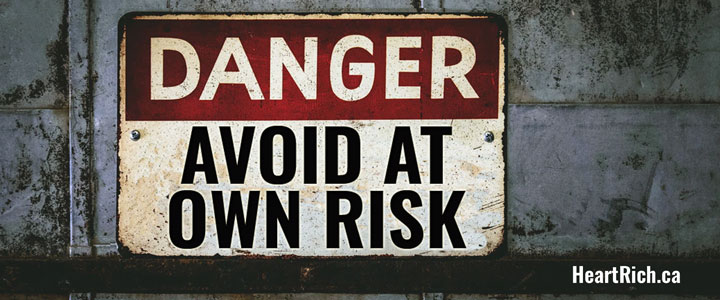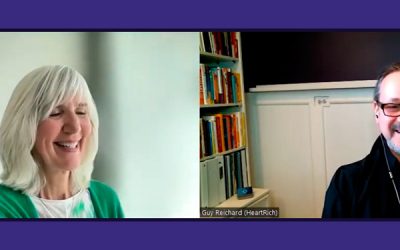When Too Much Safety Isn’t Safe
Avoidance, it’s astonishing how stealthy it can be. It may be one of your main coping strategies to keep yourself safe and secure, and you might not even realize the trap it’s been creating for you.
You’ve probably heard of our Fight or Flight Response. It’s our body’s automatic reaction to an event perceived as a threat – something that could hurt or kill you – and it’s evolved to keep you alive. There’s a lot more to it than that – if you’re interested, please see The Heart of Resilience for a Polyvagal Theory informed article on our Autonomic Nervous System, including details about our Flight Fright Freeze and Fawn responses to danger.
Avoidance, as you can imply, falls under the Flight category. The best thing we can do to stay safe and conserve our energy is to flee from danger – that is to avoid it.
I bet you’d be surprise to learn how many things your body perceives as a threat and learned, or is learning, to avoid. There is a process called Neuroception that is constantly and pre-consciously scanning the environment – both the outer world and your inner world – to detect danger of any kind and prime your body to respond quickly to keep you safe and out of harms way. It even responds to your thoughts.
What is Avoidance?
The American Psychological Association defines avoidance as “the practice or an instance of keeping away from particular situations, environments, individuals or things because of either a) the anticipated negative consequences of such an encounter or b) anxious or painful feelings associated with them.
Though we can consciously choose to avoid anything we don’t want to face or experience – this article is more about unconscious avoidance patterns we have that may include avoiding not only things in the outside world that we don’t want to face but especially the stuff in our own inner world as well, like fear, or self-critical feelings like shame.
According to ACT, a psychotherapeutic approach (Acceptance & Commitment Therapy/Training) built into the HeartRich Resilience Fundamentals, Experiential Avoidance is “any attempt to avoid uncomfortable thoughts, feelings, memories, images, physical sensations, even when doing so creates harm.”
Any attempt to halt, block, reduce, change or eliminate these unwanted inner experiences falls under the umbrella of avoidance if it also causes harm in some way down the line. Meaning this coping style can have drastic consequences.
The cost of using avoidance too much, too often has been linked to:
- Anxiety
- Depression
- Addictions
- High-risk behaviors
- Trauma & PTSD
- Obsessive Compulsive Disorder
- Eating disorders and more
Trying to escape and evade situations or people that trigger unwanted feelings are common examples. Don’t want to go to that party? Or give that speech? Yes, and also, things like procrastination when we most likely don’t even realize we have uncomfortable feelings. We just notice that we haven’t done what we wanted or needed to do, yet again.
A fair number of people who’ve reached out to me for coaching have struggled with procrastinating too much – meaning way more than they want to and it caused problems for them in both their professional and personal lives. What do you think that’s all about?
It’s avoidance. But it’s not exactly conscious and intentional.
It’s the power of the survival system at work. It’s just doing what it evolved to do – steer us away from danger and keep us alive and to do so fairly automatically – so that we don’t have to think about it.
Trying to Avoid Difficult Emotions & Feelings
Many of us avoid experiences out there, in the world, to avoid experiences in here, in our inner worlds. Our very own internal feelings have become the ‘danger’ our bodies and minds desperately want to get rid of.
Difficult and unwanted feelings of pain, fear, shame, guilt, anxiety, anger, sadness, and grief, for example. Anything that you’ve experienced before that your system deemed was too much to bear, and you never want to experience again. Except that we do. Often.
Avoidance works, for brief periods. If we have social anxiety and are asked to do something we’re not comfortable with – say attend a social gathering – our minds are going to offer us reasons and excuses not to go, and even mess with our bodies sometimes, making us anxious or even extremely tired. Our minds will try to find a way out of it, and we haven’t even said yes.
After some inner struggle, we say no – we choose to avoid, and quite quickly, we feel a sense of relief. “Phew! Got outta that one. Feel’s great.”
This bit of relief reinforces avoidance in the future.
The only thing is, the anxiety comes back and often it’s bigger. And your world and options get smaller.
That’s the Avoidance Trap. It provides some relief – and when you’re feeling so badly inside, any relief seems like a good thing.
We can try to avoid our difficult feelings by doing very positive and constructive things and not even realize that we’re causing harm to ourselves down the line. It’s quite insidious. Things like meditating, exercising, reading, working, cleaning, resting/sleeping, you get the picture.
At first, it’s often a conscious choice – e.g. not to go to a social function or to avoid a bigger opportunity at work for fear of failure or beliefs that you’re not good enough. You consciously make these choices.
Let’s get back to procrastination, to see how it might work without conscious, intentional choice.Take this example from coaching – the following is an amalgam of various clients I’ve worked with over the years to respect each individual’s privacy.
Working with Procrastination in Coaching
A respected employee gets promoted to manager. It’s somethings she’s wanted for a long time. Her new role means she’s not doing ‘the work’ anymore, she’s leading the people doing ‘the work’. The ‘work’ was something she was very proud of and enjoyed because she loved solving problems and getting things done on the spot. As a manager, she’s dealing with other kinds of problems and feels out of place.
She is assigned a task with no deadline, just something constructive to the firm that would be nice to achieve but isn’t an emergency (Quadrant II kind of stuff if you’re a Covey fan).
Turns out the new leader has been procrastinating on the project for a couple of months and though she wasn’t given a deadline, she feels anxiety when she thinks about it. She decides to bring it up with her coach.
When she brought it up, she thought she needed some help with accountability. She thought some kind of pressure or deadline and an agreement with her coach might nudge her to get it done.
The new leader and her coach explored this pathway for a bit (any issue in coaching can be explored and worked through in myriad ways) and the coach had a hunch that something else was at play. He asked to share it with her, and she was willing to take a look, even though doing so isn’t guaranteed to be comfortable. She feels vulnerable to look deeper inside but trusts herself and her coach, and is open to continuing. She also has a sense of faith or trust that this will help her grow.
Vowing a safe space without any judgment, the coach asks her to relax, center herself, and when she was ready to then share any thought, emotion, sensation, memory or urge she has relating to the project and the coach would write it in a thought bubble so she could take a look at it later.
One by one, letting anything new pop up in her experience, and writing it down without talking about it or justifying it. Just letting it be and letting it go.
-
- I’ve never done a project like this
- It’s a waste of my time
- I should be solving problems
- I want to go back to my old job
- What if they look at it and see it has no value
- I should have done it already
- What if someone catches a big mistake
- I feel tired

Coach asks, “anything else? Any feelings, sensations, urges?”
“Yeah”, she says, “anxiety, pressure in my throat, kind of a sick feeling in my stomach, some dread.”
The mere idea (in her inner world) of doing the project brings on all these emotions and sensations.
Coach asks, “is any of this familiar to you?”
“Yeah”, she says, “I remember having had the same feelings in school like 30 years ago.”
“Ok – so – how do you feel right now?” coach asks.
She says, “some relief, some pressure lifted, I’m not so worried right now. I feel a bit lighter just getting that all out there.”
“Ok – wanna continue and look at the project through different eyes and see if you get a new sense of it?” coach asks.
“Sure!” she replies.
Coach asks a series of questions and she responds in kind:
“How could doing this project be in alignment with your values?
How could this contribute in some way to the business and the team?
What strengths could you call on to do this and get engaged with it?
Are you willing to face this even if it conjures up some of this uncomfortable stuff and just let them be there as you move towards your values?”
After discussing each question, she replies, “Yes, I am. I really am. I think it would be very meaningful and important.”
“What will you do when/if those difficult thoughts and feelings come up?” coach asks.
“I’ll notice and accept them. From my experiences already, I know they kind of shrink when I take that approach and I end up learning something new about myself. I just didn’t realize I even had all this stuff in me till it started making me anxious.” she replied.
“I really acknowledge you for noticing and seeking some support. That was very brave, very loving.” coach says.
“Thanks coach! It was a bit uncomfortable at first to open up to what I was feeling inside but I feel a lot more positive and hopeful now and much more connected to myself and my values. I have a way forward and know I can do this!” she says.
Coach asks, “I believe you and know it too. Would you like me to check in with you on this next time? Feel free to update me along the way, if you like.”
“Yes, please do. And, thanks for the offer. I appreciate it.” She replies.
And the session concludes.
—- —- —-
The new leader was willing to face her own feelings. Her own unwanted, uncomfortable inner world experiences and by doing so, she freed herself.
How to Free yourself from the Avoidance Trap
Presence and Acceptance are two keys you need to free yourself from the avoidance trap.
Presence is a state of being here now: conscious, aware, alert, grounded, centered, balanced, whole, patient, content, in-flow.
Acceptance means actively choosing to open up to and allow those difficult and unwanted inner experiences. You are letting them be there – giving permission – not resisting, fighting or fleeing from them. You are not thinking and feeding the belief that life should always be comfortable and easy and without any pain or fear or discomfort. You are not making difficult feelings any bigger or worse or scarier than they really are.
The client faced her inner world in the safe space of coaching and gave voice to all this unpleasant and unwanted stuff inside her. She expressed it (breathed it out) and made some room inside. The issue then was no longer taking any of her energy to hide itself from her or keep it all in and engaging in all kinds of other avoidance behaviors. I only mentioned procrastination as the avoidance strategy but whenever anxiety, guilt, shame or other difficult feelings came up, one may try to control how they feel by various coping strategies, like meditating, exercising, drinking, bingeing on any number of things, etc. None of these are implicitly bad – obviously some are constructive and life-enhancing but when used to avoid the unwanted stuff, the unwanted stuff grows and creates more problems and harm down the line.
Getting present, connecting to her authentic self, feeling supported and safe, she was able to look at her thoughts and feelings, instead of from her thoughts and feelings. She also exercised the capacity to consider the project through different lenses, like her values and her desire to make a contribution.(These are all skills and tools covered in the Resilience Fundamentals.)
This is not to imply that some or all of those uncomfortable feelings won’t return at some point. They might and probably will but when they do, she’s more likely to let herself feel them – accept them and let them go.
As she connects more to her true self and to her heart and values, she increases her will to grow and take meaningful action forward. In a roundabout way, this upgrades her threat-detection and life protection system, and those old thoughts, emotions, sensations and memories don’t hold the same power anymore. She is growing more aware and connected to herself and learning to respond more kindly and compassionately to her own uncomfortable feelings, instead of turning away from them and avoiding them.
What about you?
Are you caught in the Avoidance Trap? If so, can you recognize what it’s costing you?
What would you want to get done, achieve, experience or move towards despite the difficult feelings it may cause? How would you shape your life differently?
If you find you struggle with procrastination, you feel stuck, stagnating, in a rut, out of place, need to make a decision or move forward but can’t – chances are avoidance is at work. If you want some help finding your way out and learning some tools and skills to help you face and accept the ‘unwanted’ stuff so you can create a rich, full and meaningful life, please reach out and set up a heart-to-heart consultation with me.
P.S. – I have a hunch some people may read this as if we have to accept feeling badly all the time and just to suck it up. No. That’s not it. Sometimes avoidance may be the best course of action but not if it’s causing harm down the line. What happens when you do face and feel those difficult feelings, and accept them as a part of life, you can put the focus on your values and creating meaning in your life, and being who you truly are. Over time, with practice, that diminishes the intensity and fear of the difficult feelings, and they don’t become a thing to avoid any more. And the amazing thing is that they do often shrink and reduce in intensity and frequency.







I think it is true that procrastination is a form of unconscious avoidance. It is helpful to be aware of this and then the question is how to motivate oneself to act even when there may be uncomfortable feelings that you have mentioned in this blog. It appears your coaching allows people to work through the emotions behind the procrastination and avoidance patterns.
Thanks for engaging and sharing your thoughts, Lesley.
Yes, that is such an important question – how do we take those courageous steps forward when we feel scared and vulnerable?
And yes again, my approach to coaching aims to help people recognize, accept and embrace their uncomfortable feelings with heart, connect to their values and take a meaningful step forward (doesn’t matter how small it seems). This builds resilience and creates fulfillment, as well as builds self-trust – a sense of faith in one’s self that ultimately reduces those uncomfortable feelings (or their impact) in the long run.
Best wishes,
Guy